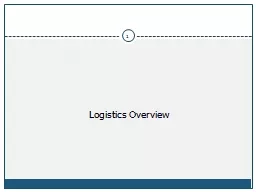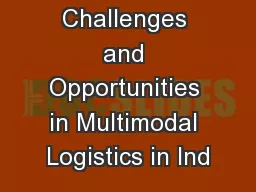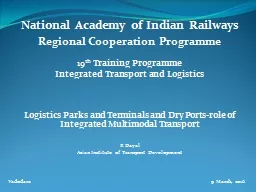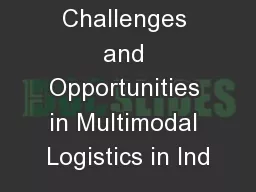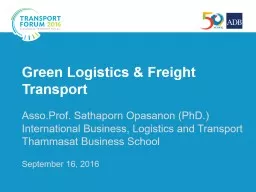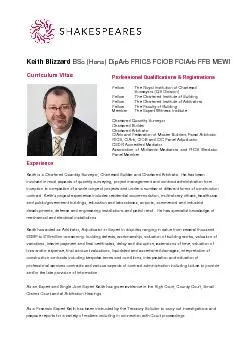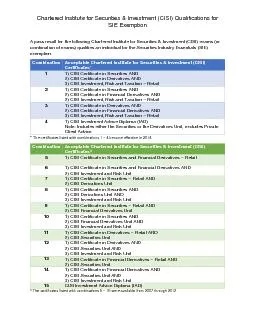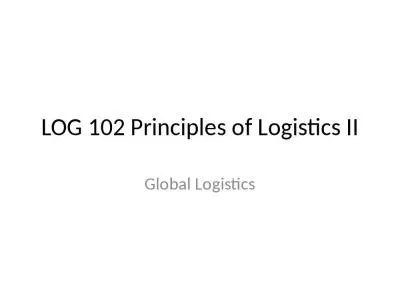PPT-The Chartered Institute of Logistics & Transport
Author : brooke | Published Date : 2023-09-19
CILT South Africa 2016 19 Business Plan Updated version 13 March 2018 BackgroundSituational Analysis for CILT South Africa 3 Transport and Logistics in South Africa
Presentation Embed Code
Download Presentation
Download Presentation The PPT/PDF document "The Chartered Institute of Logistics &am..." is the property of its rightful owner. Permission is granted to download and print the materials on this website for personal, non-commercial use only, and to display it on your personal computer provided you do not modify the materials and that you retain all copyright notices contained in the materials. By downloading content from our website, you accept the terms of this agreement.
The Chartered Institute of Logistics & Transport: Transcript
CILT South Africa 2016 19 Business Plan Updated version 13 March 2018 BackgroundSituational Analysis for CILT South Africa 3 Transport and Logistics in South Africa Current Government priorities on procurement logistics and SMMEs . Auto Trans Group is a leading auto transport and car shipping company. We are meeting the transportation needs of automotive communities to move their old, new or antique cars from one location to another. We have been serving the people with impeccable and tireless moving solutions for the past many years. CORPORATE. PROFILE. Who We Are. Who We Are. Global presence . with services being offered to all the major trade-lanes in the world. Allcargo is present in over 90 plus countries and has over 200 plus offices globally including network of agents and franchisees. Meaning . Where. , when and how the product/service should arrive to its final . destination.. The . logistics networks may be understood as the material flows (transport) between specific points (DCs, ADCs, etc.), ranging from the supply of the raw material to the delivery of the final products to consumers in an optimized fashion.. 1. Session Objectives . Definition of logistics. Logistics & supply chain management differentiation. Objectives of logistics management. Logistics Overview. 2. Logistics Origin . . The word logistics traces its origin to the Greek word logistikos and the Latin word logisticus, meaning the science of computing and calculating.. OF NIGERIA . . (. Established by act of parliament no. 15 of 1965) . . . REQUEST FOR PRACTICE REVIEWERS. The . Institute . of . Chartered Accountants . of . Nigeria (ICAN) . is continuously carrying out . Team : Alpha & Omega. Saanya. . Mehra. – MBA I (Operations). Debashish. . Chatterjee. – MBA . I (Operations. ). FACTS ABOUT LOGISTICS IN INDIA. India spends 14.4% of its GDP on logistics . Regional Cooperation Programme. 19. th. Training Programme. Integrated Transport and Logistics. Logistics Parks and Terminals and Dry Ports-role of Integrated Multimodal Transport. R . Dayal. Asian Institute of Transport Development. Team : Alpha & Omega. Saanya. . Mehra. – MBA I (Operations). Debashish. . Chatterjee. – MBA . I (Operations. ). FACTS ABOUT LOGISTICS IN INDIA. India spends 14.4% of its GDP on logistics . Facts. Charter Organization owns the unit . It also owns all the resources to include any trailers, troop camping gear, and treasury!. If a Troop leaves a Chartered Organization for another, the resources must be left behind pending any negotiated transfer agreements.. Transport. Asso.Prof. Sathaporn . Opasanon. (PhD.). International Business, Logistics and Transport. Thammasat. Business School. September 16, 2016. Concepts of Sustainability in Logistics. Importance of Green Transportation. Experience Keith is a Chartered Quantity Surveyor, Chartered Builder and Chartered Arbitrator. He has been involved in most aspects of quantity surveying, project management and contract administratio Qualifications for SIE Exemption A pass result for the following Chartered Institute for Securities & Investment (CISI) exams (or combination of exams) qualif ies an individual for the Securities LEVEL 1LEVEL 2DA1 Financial AccountingDA8 Financial ReportingDA2 Quantitative Analysis DA9 Management AccountingDA3 Business EconomicsDA10 TaxationDA4DA11 Principles of AuditingDA5 Cost AccountingDA12 Global Logistics. Definitions. International Logistics. International Logistics is the process of planning, implementing, and controlling the flow and storage of goods, services, and related information from a point of origin to a point of...
Download Document
Here is the link to download the presentation.
"The Chartered Institute of Logistics & Transport"The content belongs to its owner. You may download and print it for personal use, without modification, and keep all copyright notices. By downloading, you agree to these terms.
Related Documents




